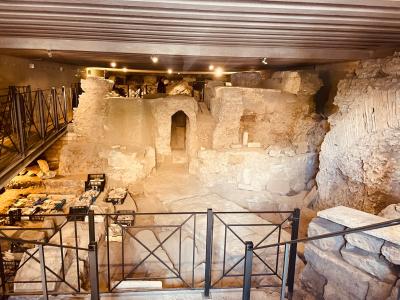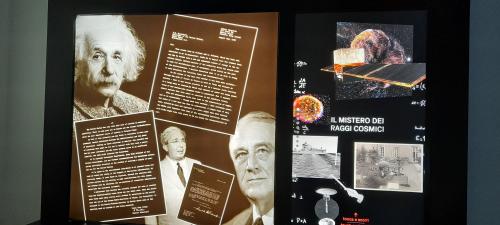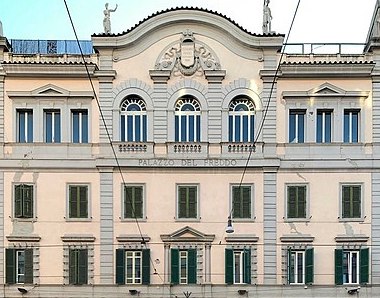Once considered Rome's least desirable 'Seventh Hill,' the Esquilino is upgrading fast

ROME -- After decades of neglect, the Esquilino, the most extensive but most misunderstood of the fabled Seven Hills of the Eternal City, is enjoying a long overdue update and revival. Sprawling over 2.7 acres of territory that extend from the Termini rail station, reaching as far as the Colosseum, the Basilica of St. John Lateran, the Tuscolano and the Tiburtino districts and encompassing the vibrant Monti quarter in the city centre, the Esquiline Hill has been known as a Roman-version Chinatown, the city's best shopping centre for exotic food and ethnic restaurants, but it had also acquired a rather murky and probably unjust image as a centre of petty crime, neglect and general degradation.
The upgrade of the main Piazza Vittorio Emanuele, the pulsing heart of the district, began a few years back when the street market that hid the view of the botanical garden in the centre of the square was moved to a new indoor state-of-the-art venue and architects began to appreciate the stylish porticoed 19th Century constructions that enclosed the piazza, as well as the numerous nearby arte nouveau buildings, such as the historic Palazzo del Freddo, that houses the celebrated Fassi icecream parlour, and the lavishly decorated Antiquario Romano, the former city Acquarium, abandoned for years and now restored as the House of Architecture.
A major change began with the construction of the headquarters of the ENPAM head office (the National Doctors and Dentists Social Security and Welfare body) facing onto the square. During building work, important archaeological finds came to light. These were so numerous that the institute decided to create a museum on the premises, called the Museo Ninfeo as the site was identified as a former monumental Nymphaeum (a water feature in the gardens of wealthy ancient Romans dedicated to the Nymphs) The area, in fact, had once been occupied by the fabled Horti Lamiani, a vast pleasure garden full of exotic plants and wild animals created by Lucius Aelius Lamia at the beginning of the 1st century AD. Among the 3000 objects on display are the bones of animals like lions, ostriches and deer that once roamed free in a virtual earthly Paradise which was ultimately incorporated into the adjoining territory of Nero's Golden House.
The gentrification process got another boost with the creation of the Palazzo Merulana art gallery and cultural centre on nearby Via Merulana. The Liberty-style building was formerly Rome's Hygiene Office. It had been abandoned for years until it was restored by entrepreneur Claudio Cerasi and his wife Elena to house their private collection of contemporary art. Its exhibition rooms and stylish ground floor cafeteria are now important hubs for exhibitions and cultural events.
Transformation has also come from within with the creation of the Esquilino Community organization that aims to upgrade andhighlight the attractions of the rione in preparation for the up-and-coming Church Jubilee in Holy Year 2025 when millions of pilgrims and tourists are expected to arrive in Rome.
Meanwhile, a cultural revival has been underway with a series of successful summer initiatives like the Port a Magica Festival, the Notte del Cinema with films projections under the night sky at the Cinevillage, a Jazz Festival and an extensive programme of complementary events like book presentations, poetry reading, philosophy lectures, musical performances and so on, as well as a string of “Wine Made in Lazio Tastings” in the central Piazza Vittorio garden.
Earlier this year, the Esquiline Community joined up with the DMO (Destination Management Organization), an international tourism promotional network, to hold a 3-day convention on the theme “Equilino Open Doors - New Hospitality – Tourism that Regenerates” involving some 20 associations connected with the quarter, including representatives of Slow Food, Cittaslow, the Fair Bnb network, International Greeter,the Palazzo Merulana Association, the Second Generation ChineseAps (associna), the Legalberi conservation body, as well as a number of private citizens' street associations, with the official backing of the Rome public administration.
Ringed by the Capitol Hill, the Viminale and the Palatine in the very heart of the city, the Esquiline has tremendous tourism potential. The district contains three major basilicas – St. Mary Major, decorated with the first gold brought by Columbus from the New World, the Basilica of the Holy Cross in Jerusalem, with relics of Christ's Passion brought to Rome (so tradition claims) by Constantine's mother and St. Praxedes with rare (for Rome) Byzantine mosaics, as well as a dozen other churches. There are two important museums – Palazzo Massimo alle Terme with an outstanding collection of Roman and Greek sculpture and the new Ninfeo Museum. There are the ruins of the Baths of Titus and those of Trajan, the so-called Trophies of Marius monument and the Auditorium of Maecenas, the ancient Roman millionaire, a close friend of the Emperor Augustus. The Esquilino also encompasses Villa Wolkonsky, the residence of the British Ambassador, the fascinating laboratory-museum of Nobel-prize winner Enrico Fermi, creator of the first nuclear reactor, and the botanical garden containing the “Magic Door” of the Alchemists.
After an ignominious start as a slaves' cemetery and communal rubbish dump, the Esquiline Hill was rediscovered during the late Roman republican era as an ideal residential location, remote from the chaos and murky summer heat of Rome. The origin of the name is under debate but the most likely interpretation is that the hill was considered a suburban area populated by “outsiders”, as opposed to the inner city dwellers (the inquilini). before its conversion into an exclusive district for the rich and privileged.
The hill was part of the first nucleus of the primitive city and traces of the defensive 6th century BC Servian Wall are visible, incorporated into the stonework of later buildings. The ancient stone Arch of Gallienus, one of the early city gates, straddles the street running alongside the Church of Saints Vito, Modestus and Crescentia, a stone's throw from St. Mary Major. This little church, dedicated to three obscure Christian martyrs, is actually the official parish church of the area. Unusually, it possesses doors both front and back, with the rear entrance opening onto the so-called “crypt” that conserves extensive archaeological remains of the Roman marketplace that lay just inside the city walls. At the moment, the site is open on the first Saturday morning and the first Sunday afternoon of the month.
The front entrance opens onto the church proper, which dates to the 15th Century. It contains the “Wicked Stone” (Vicus Sceleratus) where many early Christians were supposed to have been martyred. St Vito himself was accredited with the power of healing rabies (a recurrent danger in Medieval Rome) and saved the life of Prince Federico Colonna, who had been bitten by a rabid dog, according to the ex voto plaque on the left wall. The niched altar on the right contains a Renaissance fresco by Antoniazzo Romano, complete with the date1483.
For a totally different sightseeing experience, it is possible to visit the fascinating Enrico Fermi Museum, tucked away in the grounds of Palazzo Viminale, the former headquarters of the Italian Ministry of the Interior. The Museum is situated in the actual building where Fermi carried out his research with his team of young scientists, known as “the Boys of Via Panisperna,” since the original entrance led onto the street of that name. A small group of five of the most brilliant brains of the early 20th Century, they worked together in what was, by modern standards, a primitive lab where they achieved major breakthroughs in the budding field of quantum physics.
The group dispersed in 1938 after the introduction of the Fascist racial laws and Fermi transferred to the USA where he worked with Robert Oppenheimer during WW2 on the “Manhattan Project” (the creation of USA nuclear weapons). However, he became alarmed at the results of the detonation of the first Soviet fission bomb in 1949 and was one of the scientists who strongly but unsuccessfully opposed the development of an American bomb. Fermi died young, aware that his death was probably caused by long term close contact with radio active substances.
The Fermi Institute is still an active research institute, open for visits by prior booking, for schools and small groups, with the resident scientists personally acting as guides.
The true hub of the Esquilino, however, is Piazza Vittorio, as it is usually called. The botanical gardens, now named after Nicola Calipari, an Italian military intelligence officer shot and killed in Iran in 2005 by American soldiers while conducting a hostage to safety, were planted over a century ago and contain many old and rare exotic plants and trees. The so-called Trophies of Marius, a monumental ruin that was originally (another) Roman Nymphaeum, this time built by the emperor Severus Alexander, occupies one corner. The garden also contains sculptor Mario Rutelli's original model for the fountain that now graces Piazza della Repubblica near Termini station. Unfortunately, his initial design of entwining tritons, dolphins and a giant octopus was not appreciated by the Romans who dubbed it the Fritto Misto (Mixed Fried Fish). Rutelli was forced to modify the composition, eliminating most of the sea creatures and adding the more delectable nymphs to create the present Fountains of the Naiads.
The main “sight” of the Esquilino, drawing crowds of curious visitors, is however the mysterious Porta Magica, also called the Alchemist's Door, set into the boundary wall and guarded by two fearsome statues of the Egyptian god Bes. This stone portal came originally from the palace of the Marquis of Pietraforte, a noted 17th century student of the occult. The stone door frames are covered in esoteric symbols featuring the planets and their allegorical link to different metals. The alchemists' dream, of course, was to discover the mysterious formula that would transmute base metals into gold. According to popular belief, the key to the secret is concealed within these inscriptions. But unfortunately, so far no-one has been able to interpret them!
jp-ms


© COPYRIGHT ITALIAN INSIDER
UNAUTHORISED REPRODUCTION FORBIDDEN


